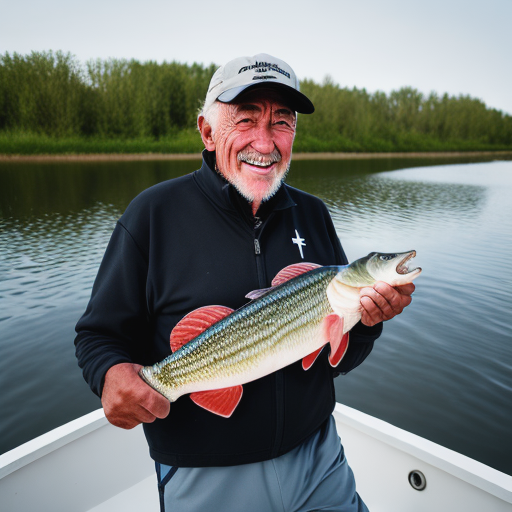The brown trout, also known as Salmo trutta, is a popular gamefish found worldwide. It is named for its distinct coloration and has a wide distribution in Europe, northern Africa, and western Asia. Brown trout prefer cold freshwater habitats such as streams, rivers, lakes, and ponds. They are known to be more predatory and piscivorous than other trout species, feeding on a variety of aquatic invertebrates, fish eggs, worms, and small baitfish. Brown trout exhibit different strains and can be found in numerous locations, including 45 U.S. states and many Canadian provinces. However, their introduction to non-native waters has had negative impacts on native fish populations in some regions.
Key Takeaways:
- Brown trout prefer cold freshwater habitats such as streams, rivers, lakes, and ponds.
- They are more predatory and piscivorous than other trout species.
- Brown trout feed on a variety of aquatic invertebrates, fish eggs, worms, and small baitfish.
- They can be found in numerous locations worldwide, including 45 U.S. states and many Canadian provinces.
- However, their introduction to non-native waters has had negative impacts on native fish populations in some regions.
Brown Trout Size and Native Range
When it comes to size, adult brown trout typically measure between 15 and 22 inches in length, weighing anywhere from 1 to 5 pounds. However, there are instances where adfluvial brown trout, which reside in lakes, can grow even larger, occasionally exceeding 20 pounds.
Brown trout are native to various regions across Europe, northern Africa, and western Asia. Countries such as France, Germany, Iceland, and Pakistan are part of their native range. They can also be found in areas of Afghanistan, Algeria, Morocco, and Russia, showcasing their adaptability to different environments.
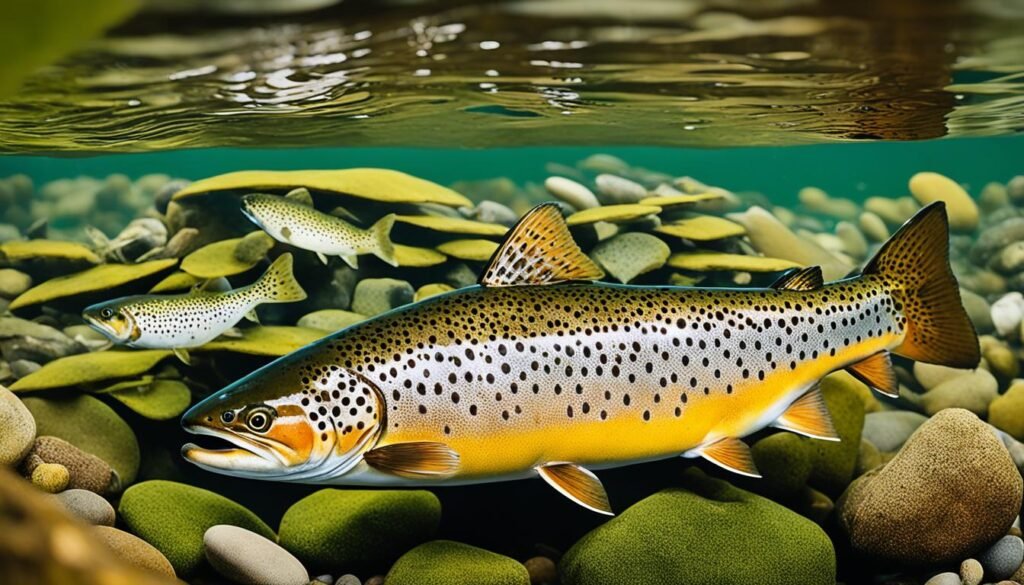
As you can see, the brown trout exhibits a wide range of sizes depending on their habitat and location. This adaptability is one of the factors that make them a fascinating species to study and pursue in fishing endeavors.
Brown Trout Life Cycle
The life cycle of brown trout is a fascinating process that begins with their transition to sexual maturity in the fall. During this time, brown trout instinctively migrate to their natal spawning grounds, driven by their natural reproductive instincts.
Once at the spawning grounds, female brown trout carefully prepare and create small depressions in the gravel riverbed called redds. These redds serve as a safe and suitable environment for the eggs to develop. The females then release their eggs into the redds, while the males release their sperm to fertilize the eggs.
The next phase of the brown trout life cycle begins with the hatching of the eggs. A significant number of eggs can be laid and fertilized, ensuring the survival of the species. After a period of incubation, the eggs hatch into fry, which are tiny and vulnerable young fish.
As the fry grow and develop, they go through various stages, such as fingerlings, where they begin to resemble adult brown trout. These young fish undergo significant physical changes and develop the ability to feed on their own.
Within their first three years of life, brown trout reach adulthood. This transformative period involves substantial growth and maturation, enabling the fish to exhibit their distinctive characteristics and behaviors.
Brown trout typically have a lifespan of four to six years, although under favorable conditions, they can live for more than ten years. This variation in lifespan is influenced by factors such as food availability, water quality, predation, and overall environmental conditions.
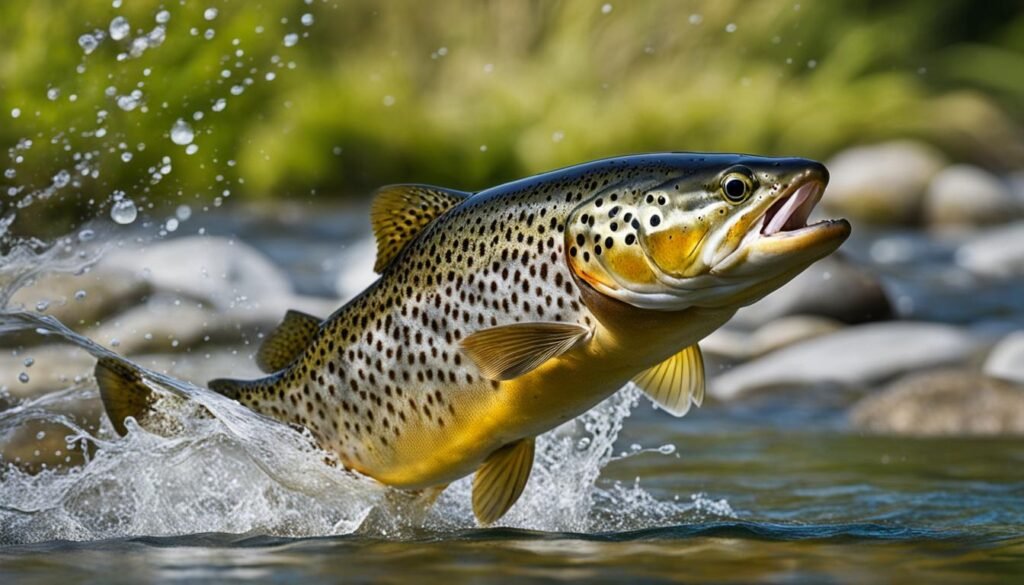
Brown Trout Life Cycle Summary:
| Stage | Description |
|---|---|
| Egg | Laid and fertilized in redds by adult brown trout |
| Fry | Young fish that hatch from eggs |
| Fingerling | Developing fish that resemble adult brown trout |
| Adult | Mature brown trout that have reached sexual maturity |
Brown Trout Diet
Brown trout are opportunistic feeders with a diverse diet that allows them to adapt to various environments. Their feeding behavior is influenced by the availability of different food sources in their habitat. Let’s take a closer look at what brown trout consume:
Aquatic Invertebrates
A significant portion of the brown trout diet consists of aquatic invertebrates. They prey on insects such as mayflies, caddisflies, stoneflies, and midges. These small organisms provide a reliable food source for brown trout, especially in streams and rivers.
Crustaceans
Brown trout also consume crustaceans found in their aquatic habitats. Crayfish, freshwater shrimp, and other small crustaceans make up an important part of their diet in some regions.
Baitfish and Fish Eggs
Brown trout are known to be cannibalistic, readily preying on smaller baitfish, including their own species. They also target the eggs of other fish, including their own, consuming them as an abundant and nutritional food source.
Worms and Zooplankton
Worms, such as earthworms and aquatic worms, are another favorite food item for brown trout. These wriggling organisms provide a high-energy meal. Additionally, they consume zooplankton, tiny aquatic animals, such as daphnia, that reside in the water column.
Brown trout are opportunistic feeders and will eat any available food source that provides more energy than they expend.
This flexibility in their diet allows brown trout to survive and thrive in various freshwater environments. They have the ability to switch between different food sources based on availability and nutritional value.
To further illustrate the brown trout diet, here is a table showcasing their main food sources:
| Food Source | Description |
|---|---|
| Aquatic Invertebrates | Mayflies, caddisflies, stoneflies, midges |
| Crustaceans | Crayfish, freshwater shrimp |
| Baitfish and Fish Eggs | Small fish, fish eggs |
| Worms and Zooplankton | Earthworms, aquatic worms, zooplankton |
In conclusion, brown trout exhibit diverse feeding behavior, making the most of the available food sources in their habitat. This adaptability is key to their survival and success as a species.
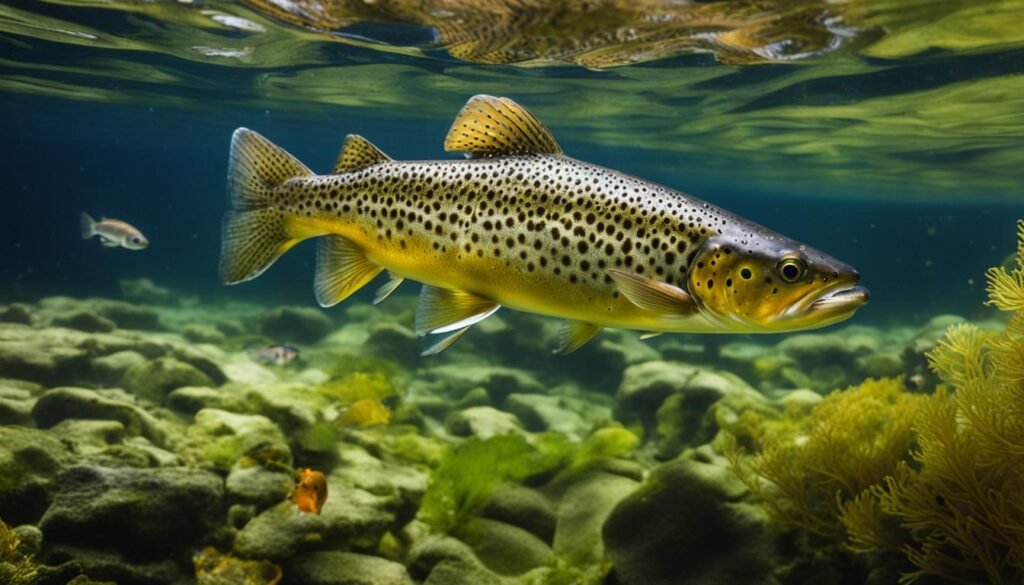
Brown Trout Locations
Brown trout are distributed worldwide and can be found on every continent except Antarctica and the Arctic. They have been introduced to various waters through stocking programs, making them widespread in 45 U.S. states, many Canadian provinces, and countries like New Zealand, Australia, and Argentina. While appreciated by anglers, their introduction to non-native waters has had negative impacts on native fish populations in certain regions.
| Continent | Countries | Regions |
|---|---|---|
| North America | United States | 45 states |
| Canada | British Columbia | |
| Alberta | ||
| Saskatchewan | ||
| Manitoba | ||
| Ontario | ||
| Quebec | ||
| New Brunswick | ||
| Nova Scotia | ||
| Prince Edward Island | ||
| Newfoundland and Labrador | ||
| Oceania | Australia | Various regions |
| South America | Argentina | Various regions |
| Chile | Various regions | |
| Uruguay | Various regions | |
| Europe | Various countries | Various regions |
| Asia | China | Various regions |
| Russia | Various regions |
“The introduction of brown trout to non-native waters has provided anglers with new opportunities to pursue these prized gamefish. However, it is important to consider the potential negative impacts on native fish populations and ecosystems. Conservation efforts should be implemented to ensure the sustainable management of brown trout locations.”
Brown Trout Habitat Preferences
Brown trout have specific habitat preferences that contribute to their optimal survival and growth. Understanding these preferences can greatly enhance your fishing success. Here are some key factors that influence brown trout habitat choices:
Cold, well-oxygenated water
Brown trout thrive in cold freshwater environments with high levels of dissolved oxygen. They are well-adapted to withstand lower temperatures compared to other trout species. This preference for cold water is one of the reasons why they tend to inhabit high-gradient, fast-flowing mountain streams.
Overhead cover
In their natural habitat, brown trout seek locations with overhead cover, such as overhanging riverbanks and tree limbs. These structures provide protection from predators and shade, creating the ideal conditions for brown trout to thrive.
Variety of freshwater environments
Brown trout are highly adaptable and can be found in a variety of freshwater environments. They inhabit streams, rivers, lakes, and ponds, making their presence widespread and accessible to anglers in different locations.
Surviving in the Atlantic Ocean
Interestingly, brown trout are capable of surviving in parts of the Atlantic Ocean where the temperature stays below 70 degrees year-round. This unique ability allows them to explore and occupy new habitats beyond freshwater systems.
To visualize the preferred habitat of brown trout, take a look at the image below:
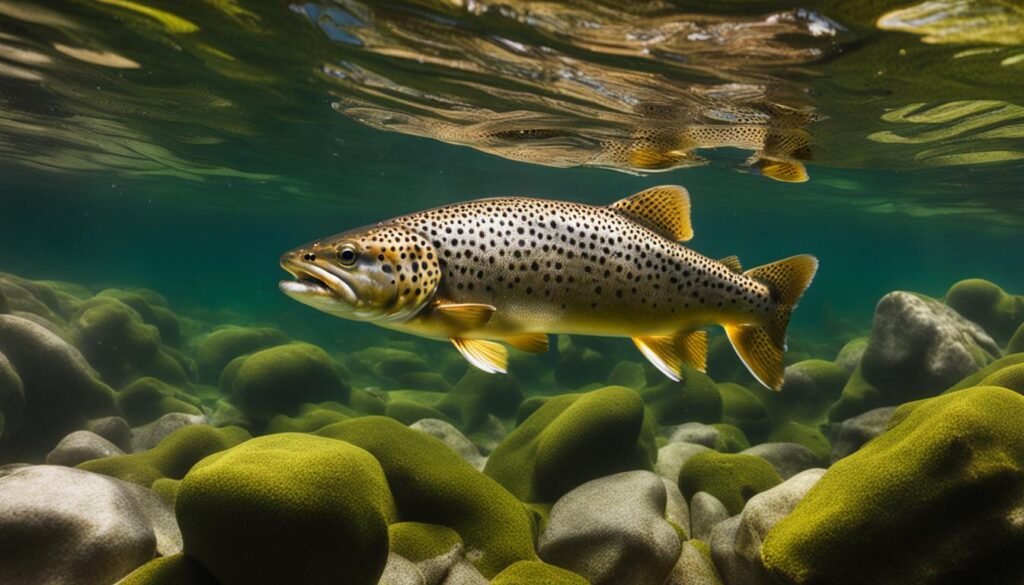
As you can see, brown trout thrive in cold, well-oxygenated waters with overhead cover. Their adaptability to various freshwater environments provides ample opportunities for anglers to enjoy fishing for these resilient and sought-after gamefish.
Strains of Brown Trout
Brown trout, known for their adaptability and widespread distribution, exhibit various strains or subtypes that possess distinct genetic differences influencing their behavior, growth rate, diet, and appearance. Understanding these different strains can help anglers fine-tune their fishing techniques for better success.
Brown Trout Strains
Seeforellen: Named after its native fishery, the Seeforellen strain of brown trout is commonly found in alpine lakes and reservoirs, thriving in cool and deep water conditions.
Loch Leven: Originating from Scotland’s Loch Leven, this strain is known for its streamlined body, making it an agile predator in rivers and lakes. Loch Leven brown trout are favored among anglers for their strong fighting ability.
German: As the name suggests, the German strain of brown trout is widely distributed throughout Germany and other European countries. They have adapted well to a range of environments and exhibit diverse dietary preferences.
Wild Rose: Native to the United States, the Wild Rose strain of brown trout is specially bred in hatcheries. These trout are released into various rivers and streams as part of conservation efforts and to enhance angling opportunities.
Gillaroo: Originating from Ireland, the Gillaroo strain of brown trout is renowned for its distinctive appearance. These fish display striking red spots, particularly on their fins, making for a visually captivating catch.
To provide a comprehensive understanding of the various brown trout strains and their characteristics, refer to the table below:
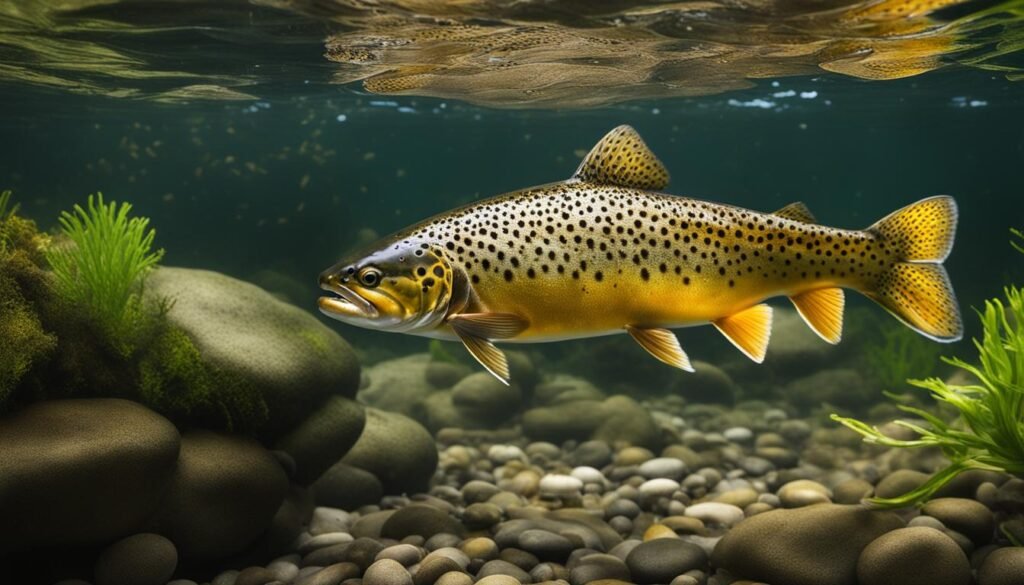
| Strain | Natural Habitat | Diet | Behavior |
|---|---|---|---|
| Seeforellen | Alpine lakes and reservoirs | Aquatic invertebrates, fish eggs, small fish | Deep-water dwellers, opportunistically feed near the surface |
| Loch Leven | Rivers, lakes | Aquatic invertebrates, small fish | Active predators with exceptional swimming abilities |
| German | Various freshwater environments | Aquatic invertebrates, crayfish, small fish | Highly adaptable, exhibit territorial behavior |
| Wild Rose | Released into rivers and streams | Varies based on release location | Acclimate to new environments, exhibit natural behavior |
| Gillaroo | Rivers | Aquatic invertebrates, small fish | Adept at catching prey near the water’s surface |
Fishing for Brown Trout
When it comes to targeting brown trout, fly fishing is a popular and effective technique. Fly fishing allows anglers to mimic the various food sources of brown trout, increasing their chances of success. Whether you’re using dry flies, nymphs, or streamers, the key is to imitate the natural prey of these fish.
When selecting your gear, consider using fly rods ranging from three to six weights for brown trout. This range provides the necessary flexibility and control to make accurate casts and present your flies effectively.
In addition to fly fishing, other techniques can also be successful in catching brown trout. Trolling methods, as well as using small spinners or baits, can entice these fish to strike.
Regardless of the technique you choose, patience is often the key to success when fishing for brown trout. Understanding their feeding behavior and adapting your approach accordingly can greatly improve your chances of landing a trophy fish.

Quick Tips for Fishing Brown Trout:
- Use fly fishing gear with a three to six weight rod.
- Imitate the natural food sources of brown trout with dry flies, nymphs, and streamers.
- Consider trolling methods and small spinners or baits as alternative techniques.
- Be patient and adapt your approach based on the feeding behavior of brown trout.
“Fishing for brown trout is a thrilling and rewarding experience for any angler. Whether you’re casting a fly or trolling a bait, these fish are known for their fighting spirit and can provide hours of entertainment on the water.” – John Smith, Experienced Angler
Brown Trout Reproduction and Spawning
Reproduction is a vital part of the brown trout life cycle. These fish reproduce through sexual reproduction, with specific behaviors associated with spawning. The process begins with the females digging nests called redds in the riverbed to lay and fertilize their eggs. This behavior prepares the optimal environment for successful egg development and hatching.

The brown trout’s spawning season typically occurs in the fall and early winter when water temperatures are suitable for egg fertilization and development. During this time, the males become more aggressive, competing with each other to gain access to the females and ensure the successful fertilization of their eggs.
After the eggs are fertilized, they undergo a period of incubation, which can vary in duration depending on water temperature and conditions. Once the eggs hatch, the fry emerge in the spring, and their journey towards adulthood begins.
It is fascinating to observe the brown trout’s mating rituals and spawning behavior, as it showcases their instinctual drive for reproduction and ensures the continuation of their species.
Eating Brown Trout
Brown trout can be a delicious and healthy addition to the diet. Their mild, slightly sweet flavor and firm texture make them a versatile fish that can be prepared in various ways. Whether you prefer grilling, pan-frying, or baking, there are plenty of options to suit your taste.
When cooking brown trout, it’s important to avoid overcooking to prevent the meat from becoming dry and tough. Here are some tips to help you achieve the perfect results:
- Grilling: Preheat your grill to medium-high heat and lightly oil the grates to prevent sticking. Place the trout fillets on the grill, skin-side down, and cook for about 4-6 minutes per side, or until the meat is opaque and flakes easily with a fork. For added flavor, you can marinate the fillets in lemon juice and herbs before grilling.
- Pan-frying: Heat a tablespoon of oil in a skillet over medium-high heat. Season the trout fillets with salt and pepper, and place them in the hot skillet, skin-side down. Cook for 3-4 minutes per side, or until the skin is crispy and the flesh is cooked through. Serve with a squeeze of lemon juice for a refreshing touch.
- Baking: Preheat your oven to 400°F (200°C). Place the seasoned trout fillets on a baking sheet lined with parchment paper. Bake for 10-12 minutes, or until the fish is opaque and easily flakes with a fork. You can add a butter and herb topping before baking for extra flavor.
Remember to experiment with different seasonings and flavors to enhance the taste of your brown trout. Fresh herbs like dill and parsley, as well as citrus fruits like lemon or lime, can complement the natural flavors of the fish. Enjoy your culinary adventure with brown trout!
Here’s a table summarizing the cooking methods for brown trout:
| Cooking Method | Time | Result |
|---|---|---|
| Grilling | 4-6 minutes per side | Firm and flaky fillets with a smoky flavor |
| Pan-frying | 3-4 minutes per side | Crispy skin with moist and tender flesh |
| Baking | 10-12 minutes | Tender and flaky fillets with a mild, delicate taste |
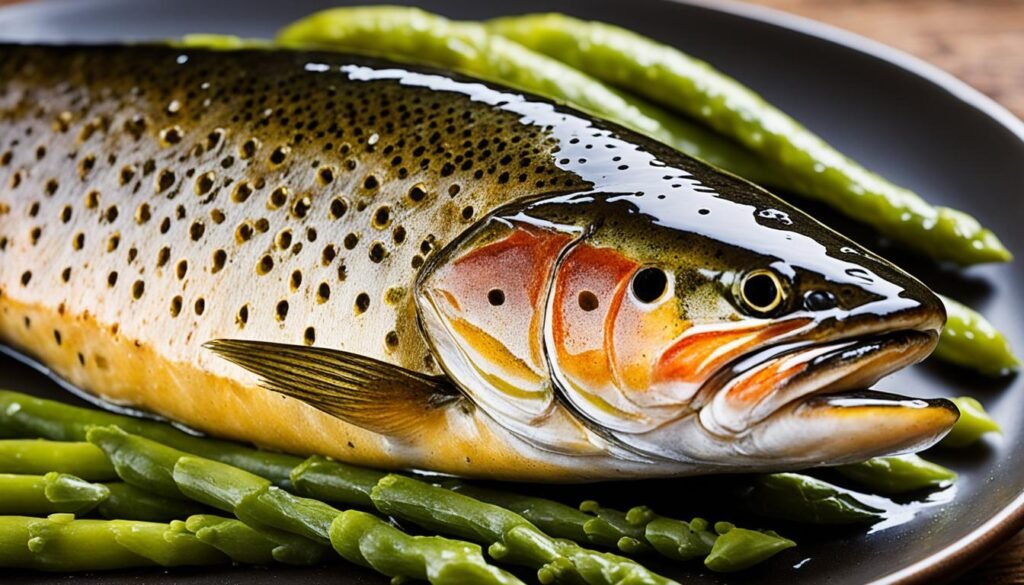
Conclusion
In conclusion, brown trout are versatile gamefish that thrive in various cold freshwater habitats around the world. They exhibit specific habitat preferences and primarily feed on aquatic invertebrates and small baitfish. Understanding their behavior and employing the right fishing techniques can significantly enhance the chances of a successful catch. However, it is important to note that the introduction of brown trout into non-native waters has had detrimental effects on the native fish populations in certain regions.
Despite this, brown trout continue to be highly sought after by anglers due to their aggressive nature, fighting ability, and culinary appeal. Their adaptability and wide distribution make them an exciting species to target while enjoying the beauty of cold freshwater environments. Whether you prefer fly fishing, trolling, or spinners, brown trout provide a thrilling angling experience for fishing enthusiasts of all skill levels. Furthermore, their mild, slightly sweet flavor and firm texture make them a delicious addition to any meal.
In summary, brown trout are a remarkable species with specific habitat preferences and feeding habits. While they have made a significant impact in the angling community, it is crucial to balance their introduction into non-native waters to avoid negatively affecting native fish populations. Overall, brown trout offer an exhilarating fishing experience and a delectable treat on the dinner table.
FAQ
What are the habitat preferences of brown trout?
Brown trout prefer cold freshwater habitats such as streams, rivers, lakes, and ponds. They thrive in well-oxygenated water and show a preference for high-gradient, fast-flowing mountain streams. They seek locations with overhead cover, like overhanging riverbanks and tree limbs.
What do brown trout eat?
Brown trout have a varied diet that includes aquatic invertebrates such as mayflies, caddisflies, stoneflies, and midges. They also consume crustaceans, small baitfish (including their own species), fish eggs, worms, zooplankton, and daphnia. They are opportunistic feeders and will eat any available food source that provides more energy than they expend.
Where can brown trout be found?
Brown trout are distributed worldwide and can be found on every continent except Antarctica and the Arctic. They have been introduced to various waters through stocking programs, making them widespread in 45 U.S. states, many Canadian provinces, and countries like New Zealand, Australia, and Argentina.
What are the preferred feeding areas for brown trout?
Brown trout prefer areas in their habitat that provide cover and ambush points for their prey. This includes locations with overhead cover, such as overhanging riverbanks and tree limbs, and areas with structure like rocks, fallen trees, and submerged vegetation.
How long do brown trout live?
Brown trout typically live for four to six years, but can live to be over ten years old under favorable conditions.
What strains of brown trout exist?
Brown trout exhibit different strains or subtypes, each with slight genetic differences that affect their spawning behavior, growth rate, diet, and appearance. Some common strains include Seeforellen, Loch Leven, German, Wild Rose, and Gillaroo.
What are some techniques for fishing brown trout?
Brown trout are a popular target for fly fishing. Techniques include using dry flies, nymphs, and streamers to imitate their various food sources. They can also be caught using trolling methods and small spinners or baits. Understanding their feeding behavior and preferred fishing techniques can lead to a successful catch.
How do brown trout reproduce?
Brown trout reproduce through sexual reproduction. Female brown trout dig spawning beds, known as redds, to lay and fertilize their eggs. The spawning season typically occurs in the fall and early winter. After hatching, the fry emerge in the spring and begin their development into adults.
Are brown trout a good fish to eat?
Brown trout can be a delicious and healthy addition to the diet. They have a mild, slightly sweet flavor and a firm texture. Brown trout can be cooked by grilling, pan-frying, or baking, and can be enhanced with lemon juice and herbs for added flavor. However, be careful not to overcook brown trout to prevent dry and tough meat.

